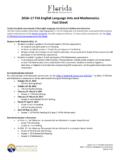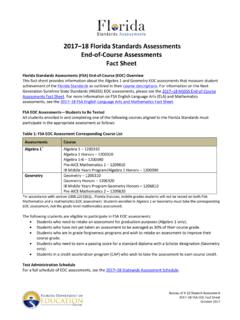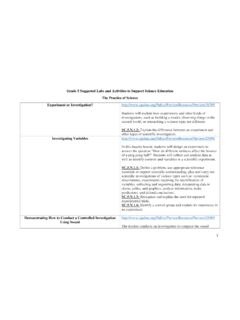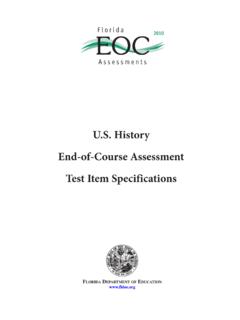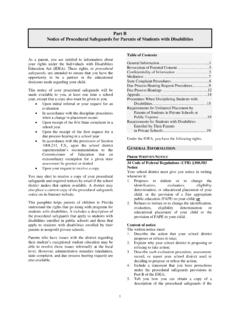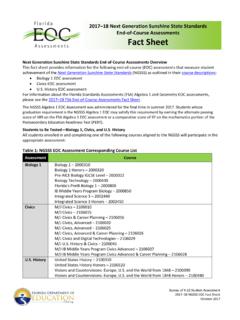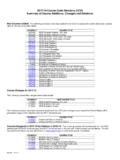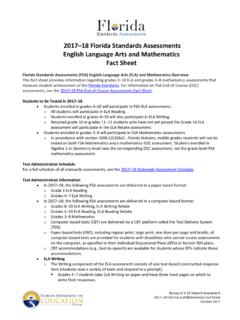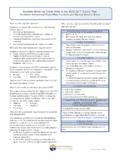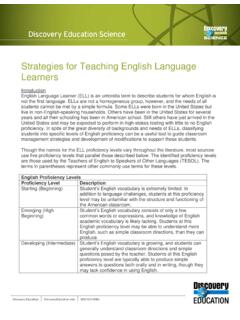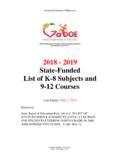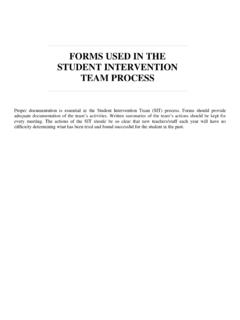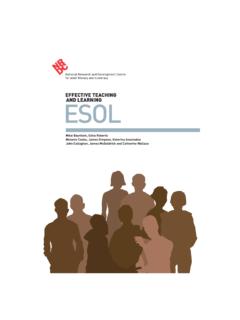Transcription of FLORIDA ESOL TEACHER PROFESSIONAL DEVELOPMENT …
1 FLORIDA TEACHER STANDARDS for ESOL ENDORSEMENT 2010 Domain 1: Culture (Cross-Cultural Communications) Standard 1: Culture as a Factor in ELLs Learning Teachers will know and apply understanding of theories related to the effect of culture in language learning and school achievement for ELLs from diverse backgrounds. Teachers will identify and understand the nature and role of culture, cultural groups, and individual cultural identities. Performance Indicators a. Understand and apply knowledge about cultural values and beliefs in the context of teaching and learning of ELLs, from diverse backgrounds and at varying english proficiency levels. Understand and apply knowledge of concepts of cultural competence, particularly knowledge about how cultural identities affect learning and academic progress for students from diverse backgrounds and at varying english proficiency levels.
2 Use a range of resources in learning about the cultural experiences of ELLs and their families to guide curriculum DEVELOPMENT and instruction. d. Understand and apply knowledge about the effects of racism, stereotyping, and discrimination in teaching and learning of ELLs from diverse backgrounds and at varying english proficiency levels. Understand and apply knowledge about home/school connections to build partnerships with ELLs families ( , Parent Leadership Councils (PLC). Understand and apply knowledge about concepts related to the interrelationship between language and culture for students from diverse backgrounds and at varying english proficiency levels. Domain 2: language and Literacy (Applied Linguistics) Standard 1: language as a System Teachers will demonstrate understanding of language as a system, including phonology, morphology, syntax, semantics and pragmatics; support ELLs acquisition of english in order to learn and to read, write, and communicate orally in english .)
3 Performance Indicators Demonstrate knowledge of the components of language and understanding of language as an integrative and communicative system. Apply knowledge of phonology (the sound system), morphology (the structure of words), syntax (phrase and sentence structure), semantics (word/sentence meaning), and pragmatics (the effect of context on language ) to support ELLs DEVELOPMENT of listening, speaking, reading, and writing (including spelling) skills in english . Demonstrate knowledge of rhetorical and discourse structures as applied to second language and literacy learning. Demonstrate proficiency in english and model for ELLs the use of appropriate forms of english for different purposes.
4 Identify similarities and differences between english and other languages reflected in the ELL student population. Standard 2: language Acquisition and DEVELOPMENT Teachers will understand and apply theories and research on second language acquisition and DEVELOPMENT to support ELLs learning. Performance Indicators Demonstrate understanding of current and past theories and research in second language acquisition and bilingualism as applied to ELLs from diverse backgrounds and at varying english proficiency levels. Recognize the importance of ELLs home languages and language varieties, and build on these skills as a foundation for learning english .
5 Understand and apply knowledge of sociocultural, sociopolitical, and psychological variables to facilitate ELLs learning of english . Understand and apply knowledge of the role of individual learner variables in the process of learning english as a second language . Standard 3: Second language Literacy DEVELOPMENT Teachers will demonstrate an understanding of the components of literacy, and will understand and apply theories of second language literacy DEVELOPMENT to support ELLs learning. Performance Indicators Understand and apply current theories of second language reading and writing DEVELOPMENT for ELLs from diverse backgrounds and at varying english proficiency levels.
6 Demonstrate understanding of similarities and differences between L1 (home language ) and L2 (second language ) literacy DEVELOPMENT . c. Demonstrate understanding of how L1 literacy influences L2 literacy DEVELOPMENT and apply this to support ELLs learning. Understand and apply knowledge of sociocultural, sociopolitical, and psychological variables to facilitate ELLs L2 literacy DEVELOPMENT in english . Understand and apply knowledge of how principles of phonology, morphology, syntax, semantics, and discourse affect L2 reading and writing DEVELOPMENT . Domain 3: Methods of Teaching english to Speakers of other Languages (ESOL) Standard 1: ESL/ESOL Research and History Teachers will demonstrate knowledge of history, public policy, research and current practices in the field of ESL/ESOL teaching and apply this knowledge to improve teaching and learning for ELLs.
7 Performance Indicators Demonstrate knowledge of L2 teaching methods in their historical context. Demonstrate awareness of current research relevant to best practices in second language and literacy instruction. Demonstrate knowledge of the evolution of laws and policy in the ESL profession, including program models for ELL instruction. Standard 2: Standards-Based ESL and Content Instruction Teachers will know, manage, and implement a variety of teaching strategies and techniques for developing and integrating ELLs english listening, speaking, reading, and writing skills. The TEACHER will support ELLs access to the core curriculum by teaching language through academic content.
8 Performance Indicators a. Organize learning around standards-based content and language learning objectives for students from diverse backgrounds and at varying english proficiency levels. Develop ELLs L2 listening skills for a variety of academic and social purposes. Develop ELLs' L2 speaking skills for a variety of academic and social purposes. Provide standards-based instruction that builds upon ELLs oral english to support learning to read and write in english . Provide standards-based reading instruction appropriate for ELLs from diverse backgrounds and at varying english proficiency levels. Provide standards-based writing instruction appropriate for ELLs from diverse backgrounds and at varying english proficiency levels.
9 G. Develop ELLs writing through a range of activities, from sentence formation to expository writing. h. Collaborate with stakeholders to advocate for ELLs equitable access to academic instruction (through traditional resources and instructional technology). Use appropriate listening, speaking, reading, and writing activities in teaching ELLs from diverse backgrounds and at varying english proficiency levels. Incorporate activities, tasks, and assignments that develop authentic uses of the second language and literacy to assist ELLs in learning academic vocabulary and content-area material. k. Provide instruction that integrates listening, speaking, reading, and writing for ELLs of diverse backgrounds and varying english proficiency levels.
10 Standard 3: Effective Use of Resources and Technologies Teachers will be familiar with and be able to select, adapt and use a wide range of standards-based materials, resources, and technologies. Performance Indicators Use culturally responsive/sensitive, age-appropriate and linguistically accessible materials for ELLs of diverse backgrounds and varying english proficiency levels. Use a variety of materials and other resources, including L1 resources, for ELLs to develop language and content-area skills. Use technological resources ( , Web, software, computers, and related media) to enhance language and content-area instruction for ELLs of diverse backgrounds and varying english proficiency levels.
